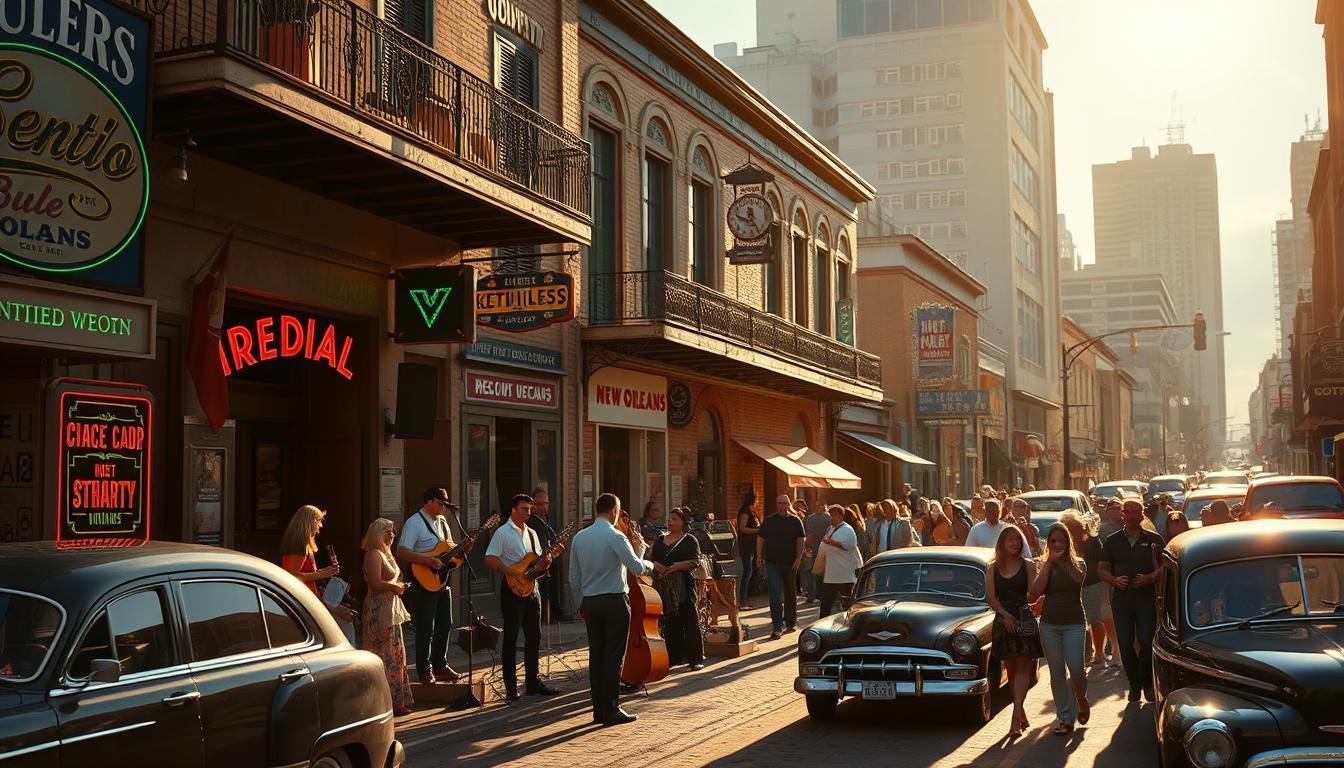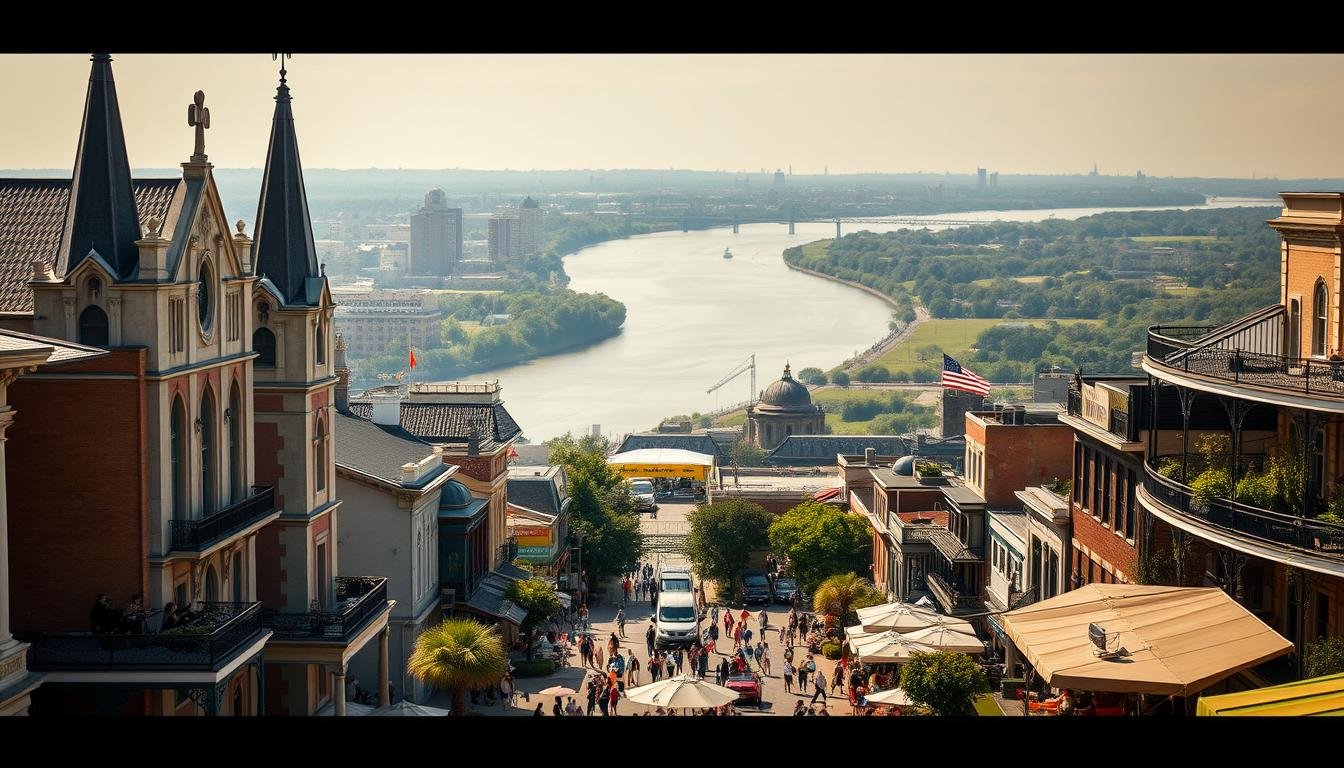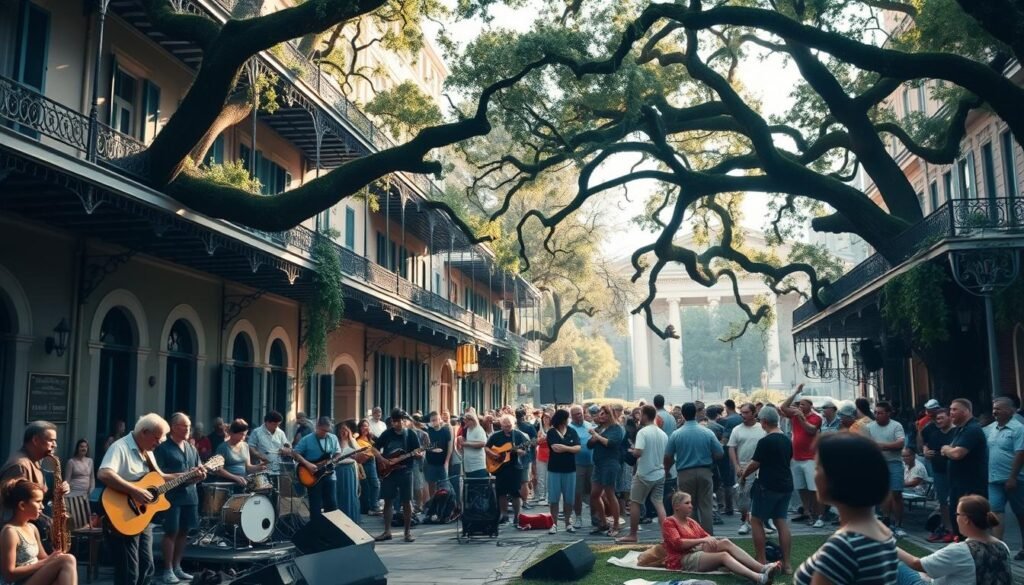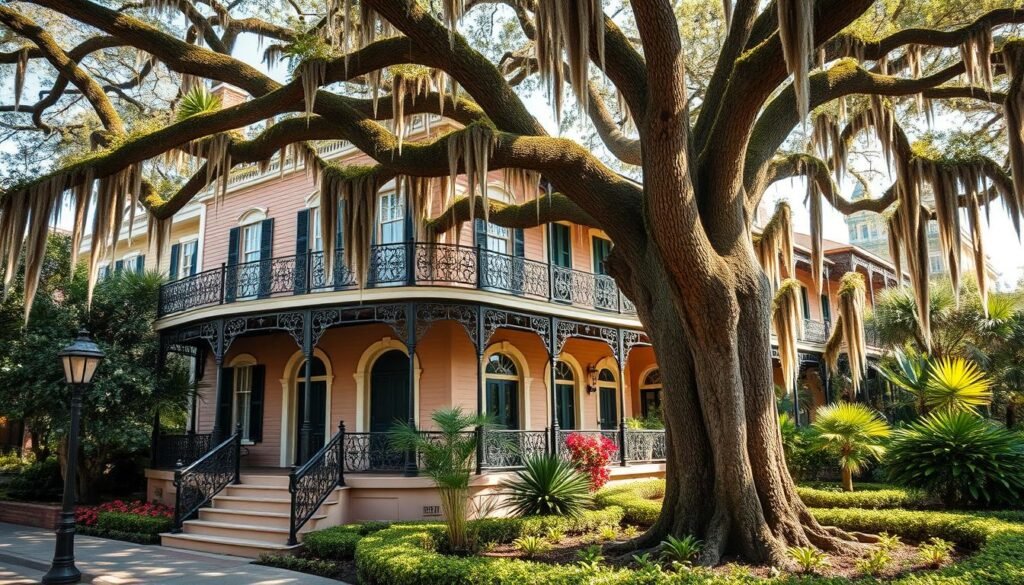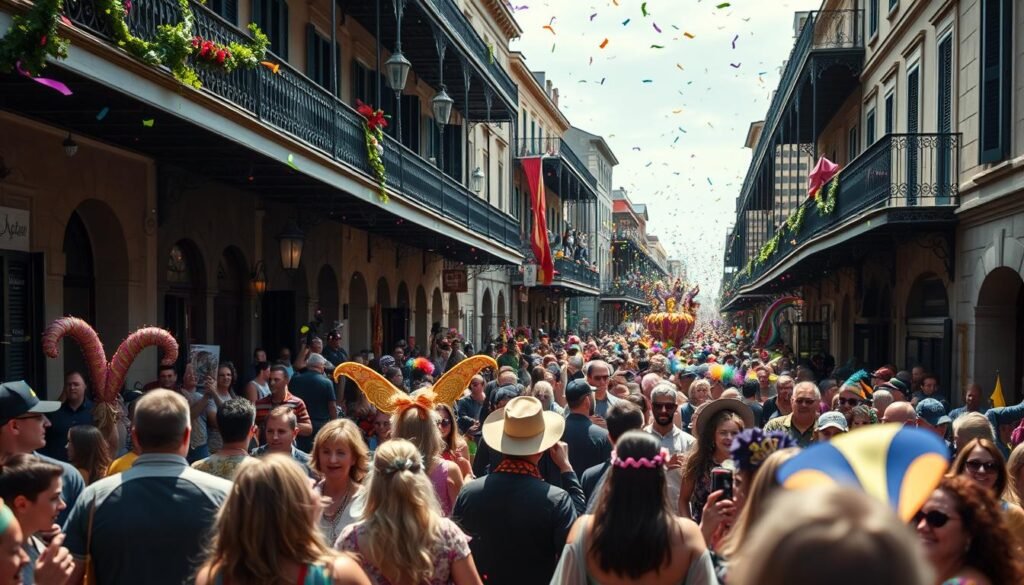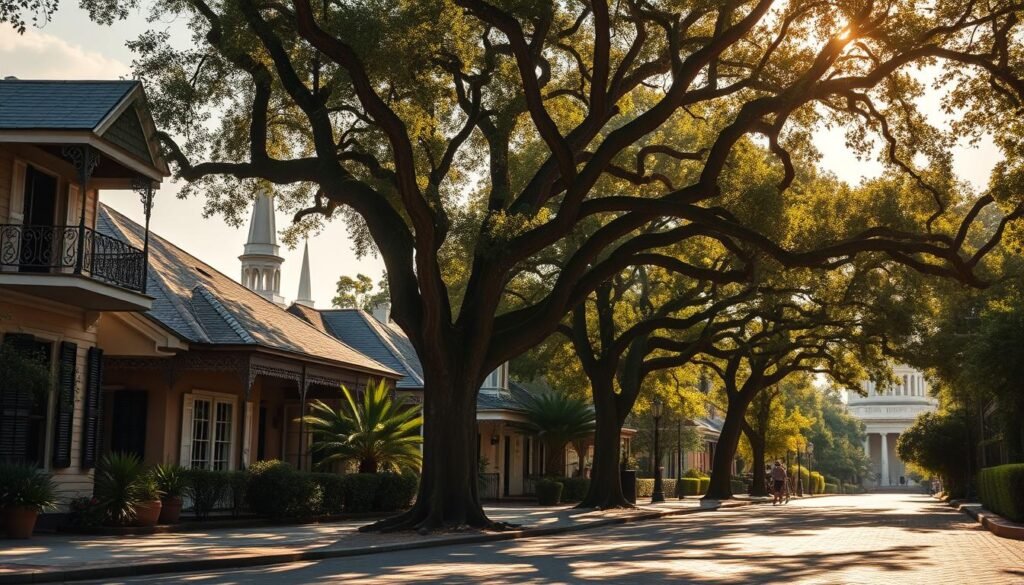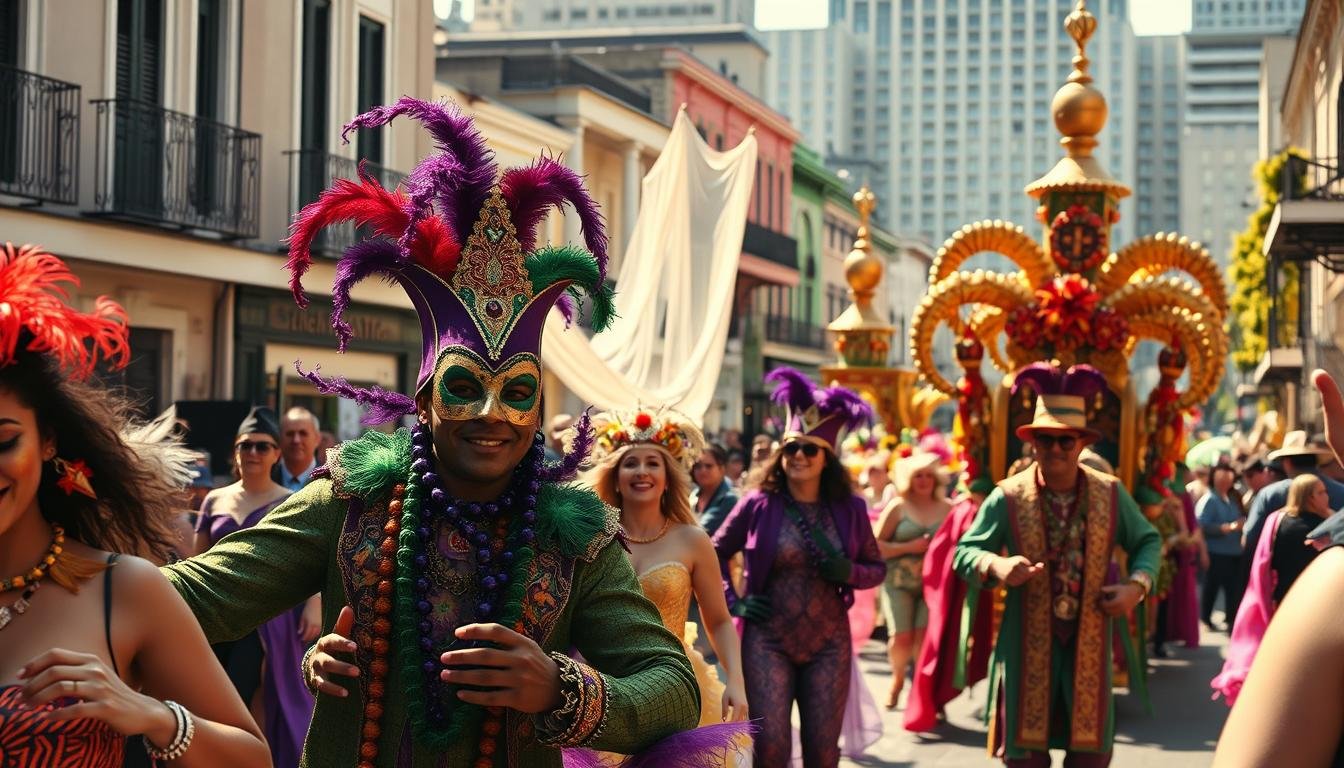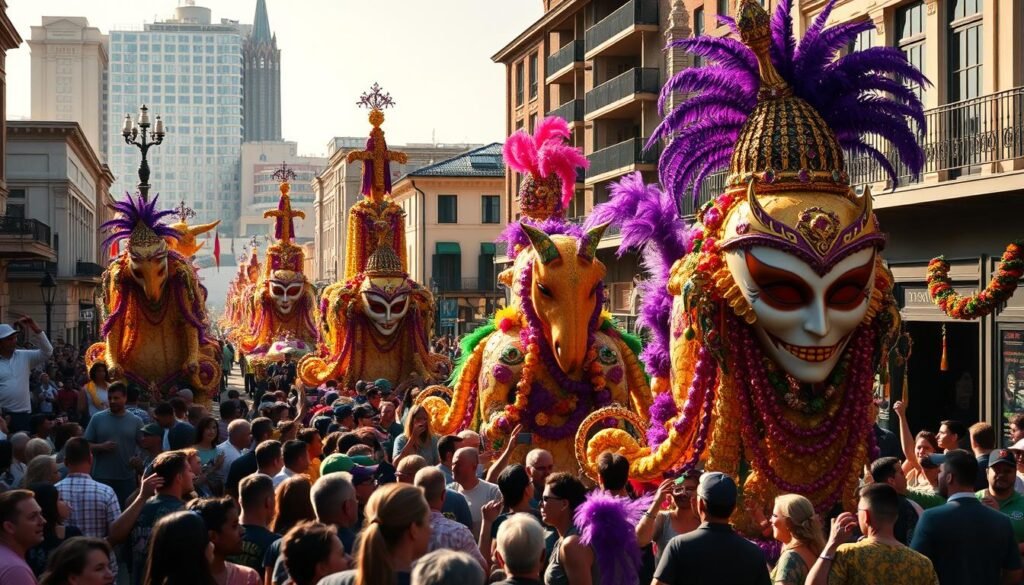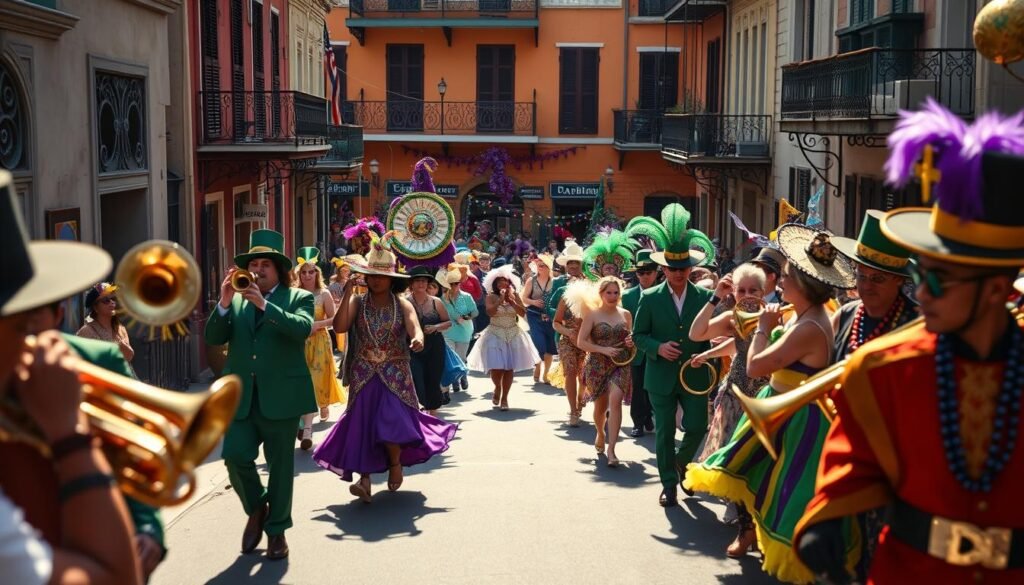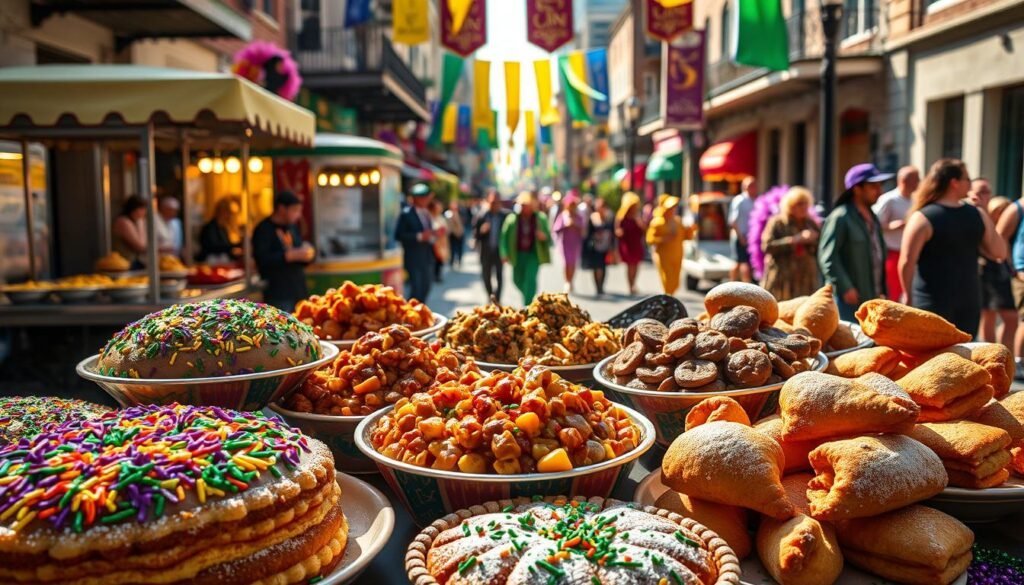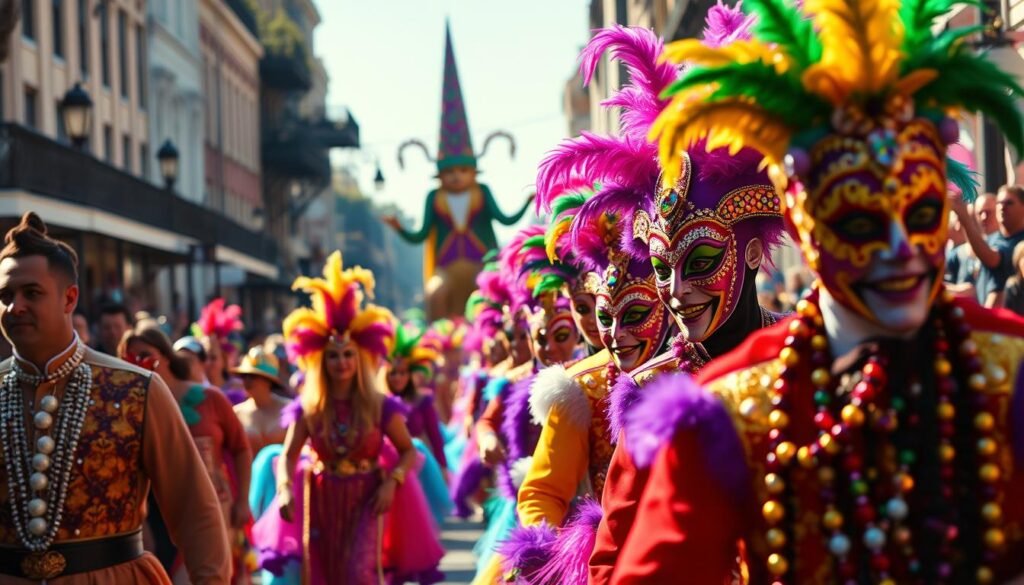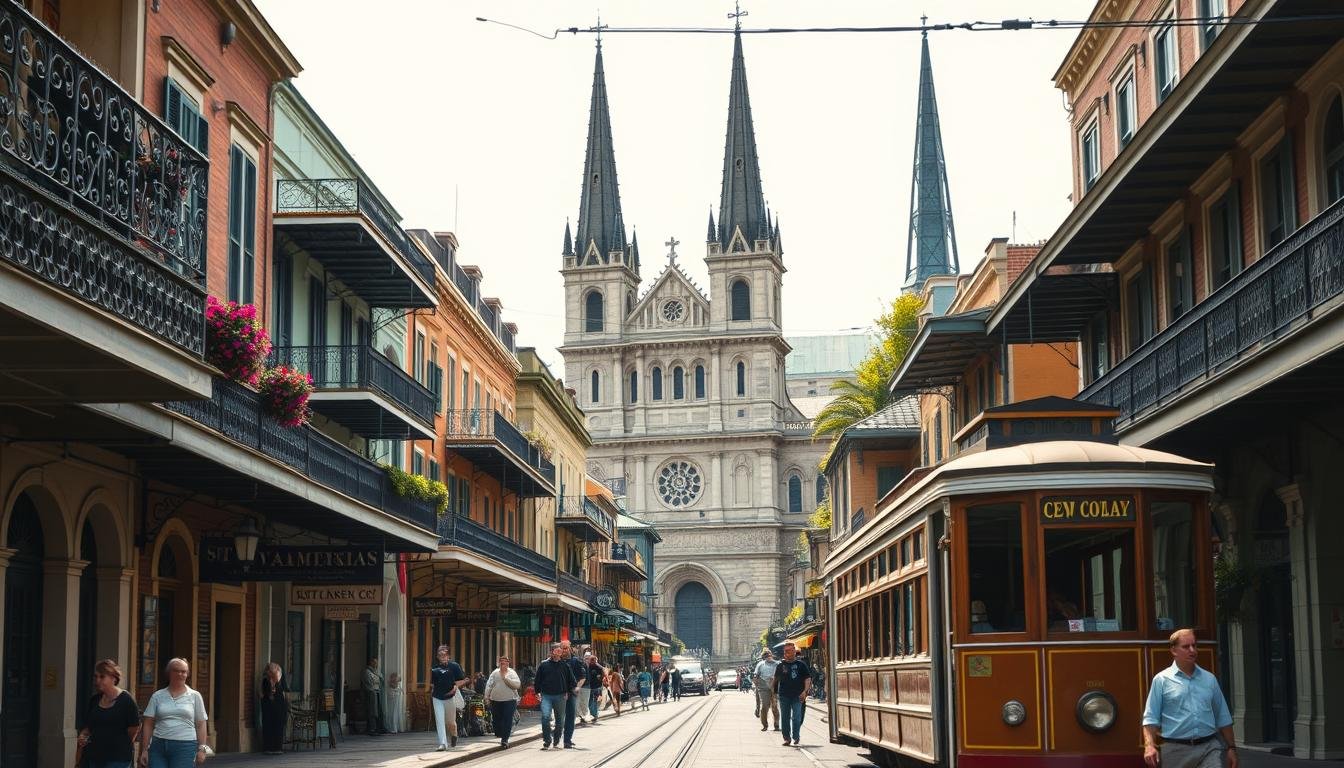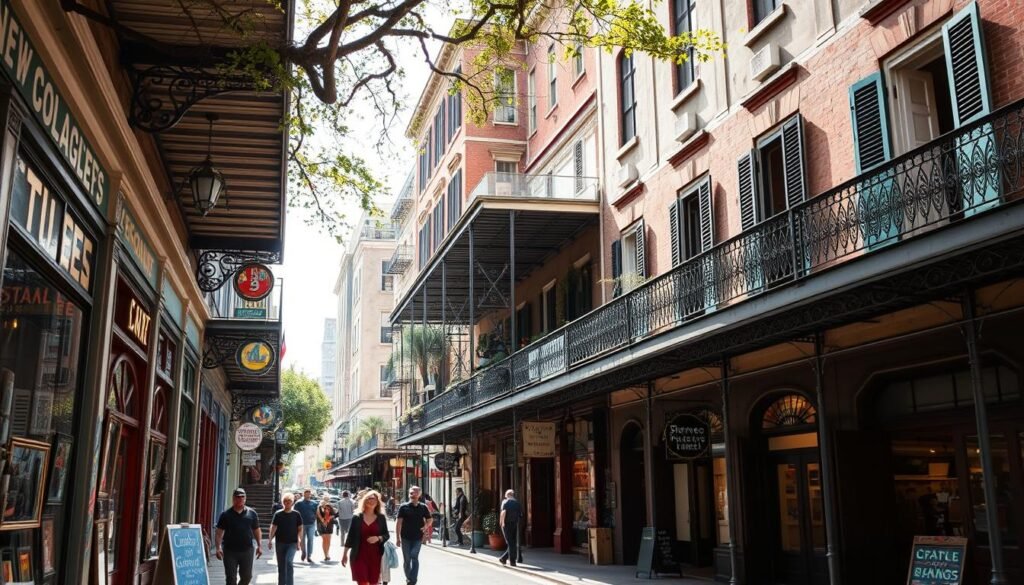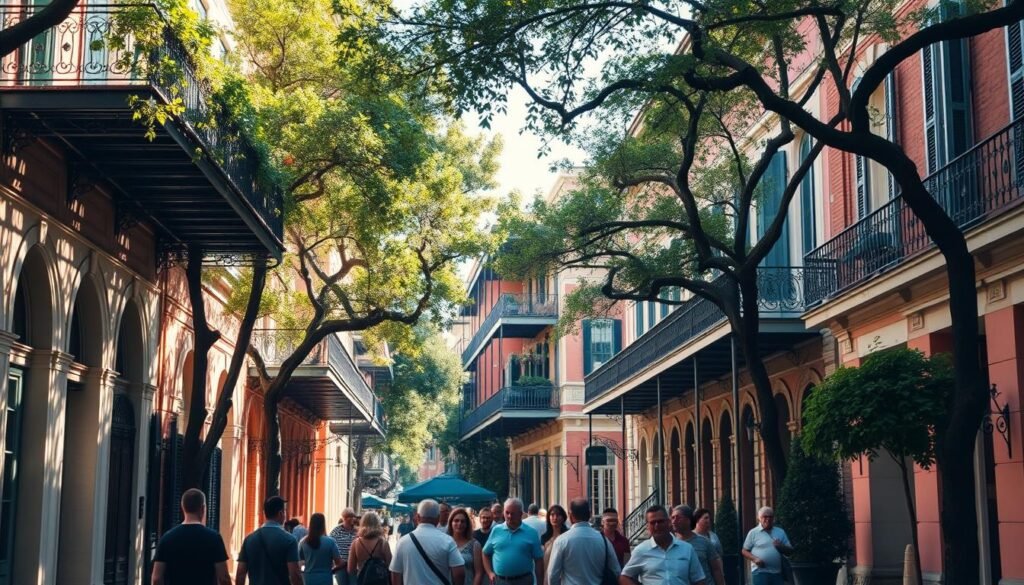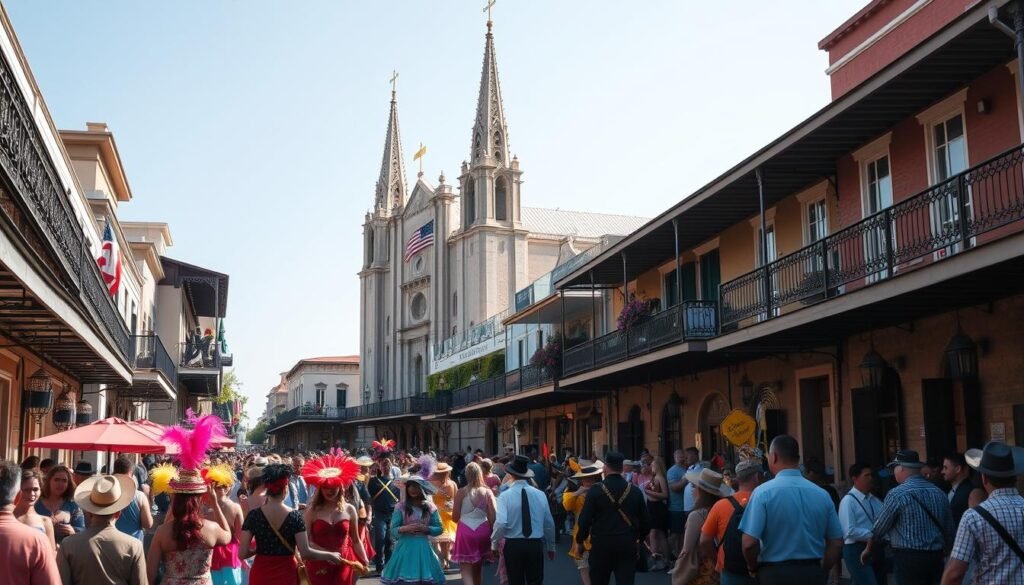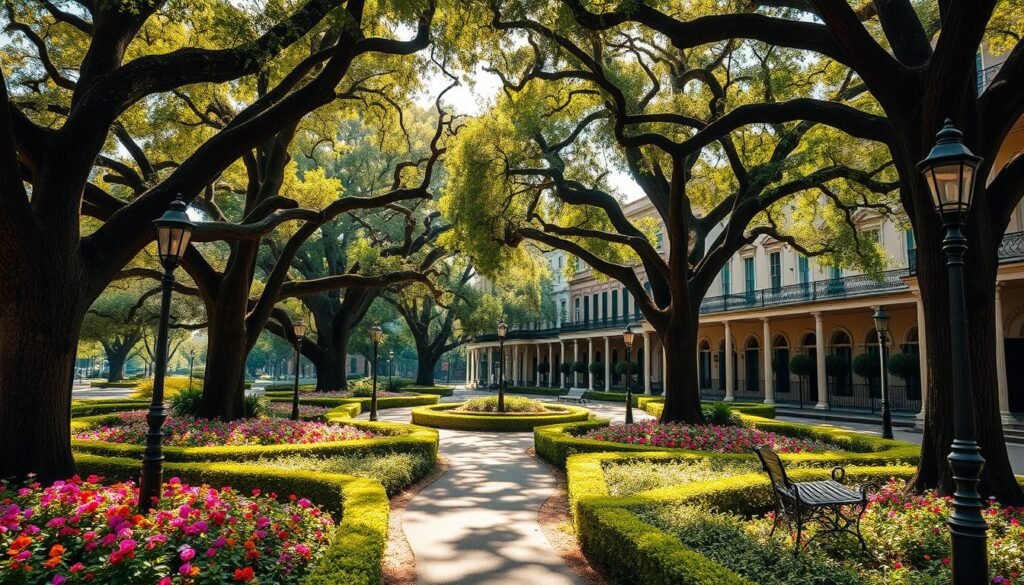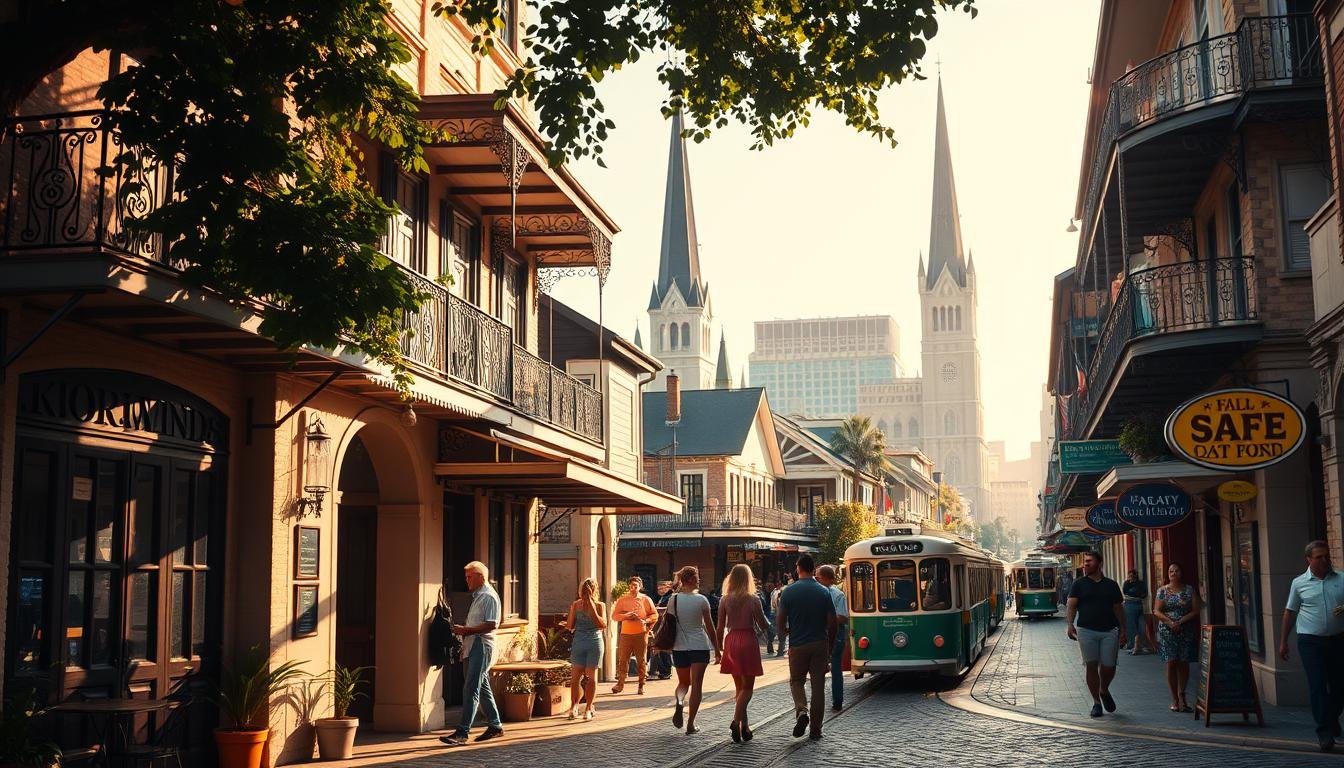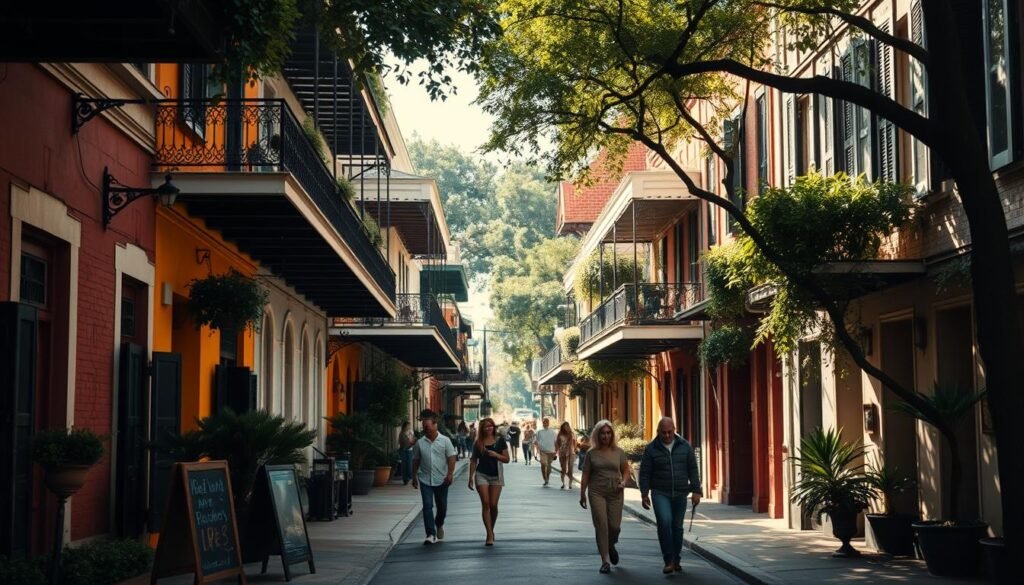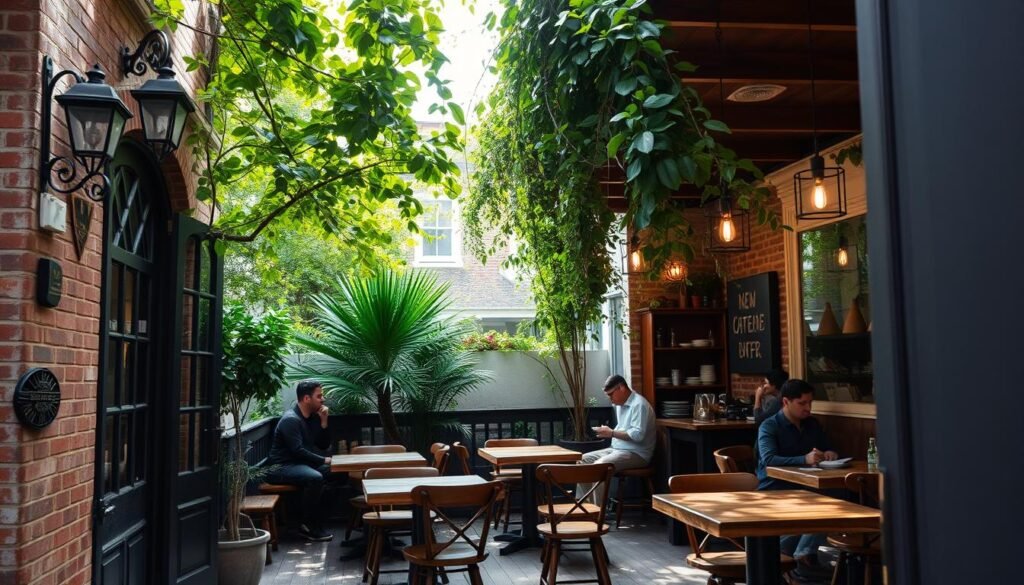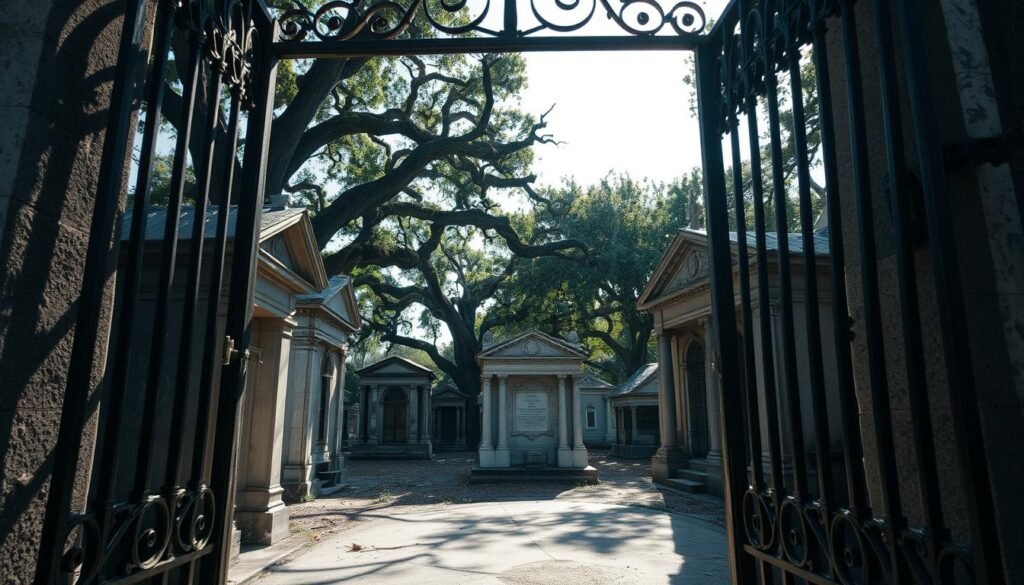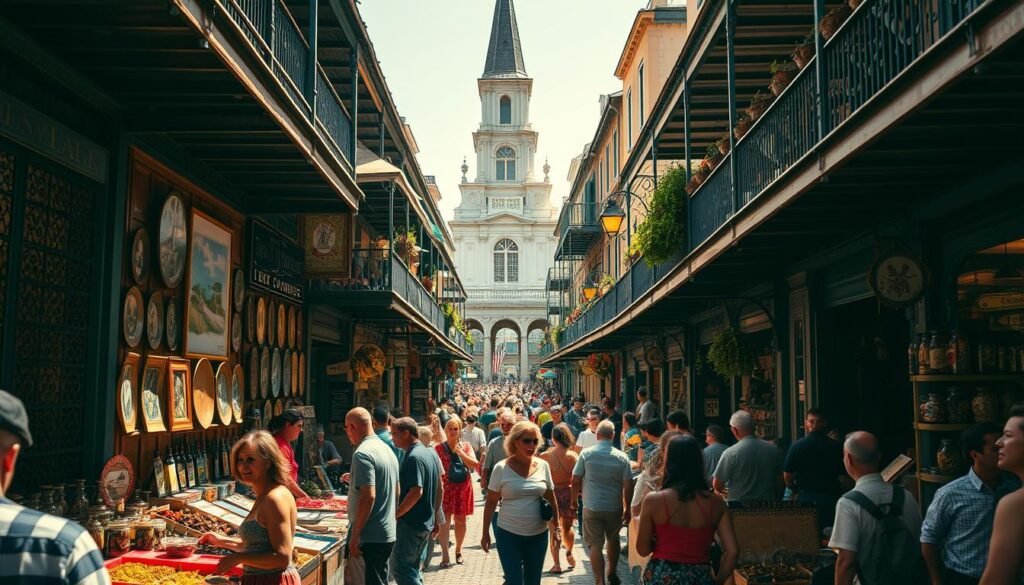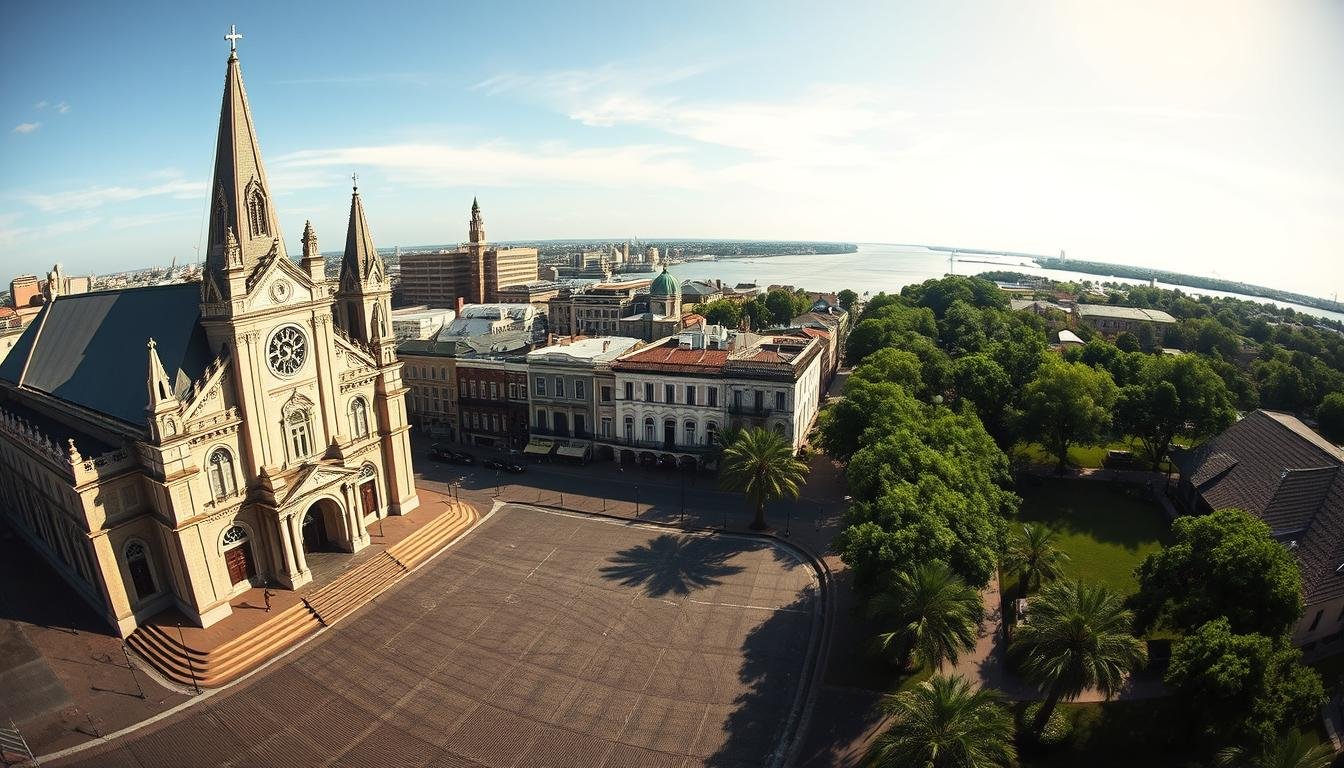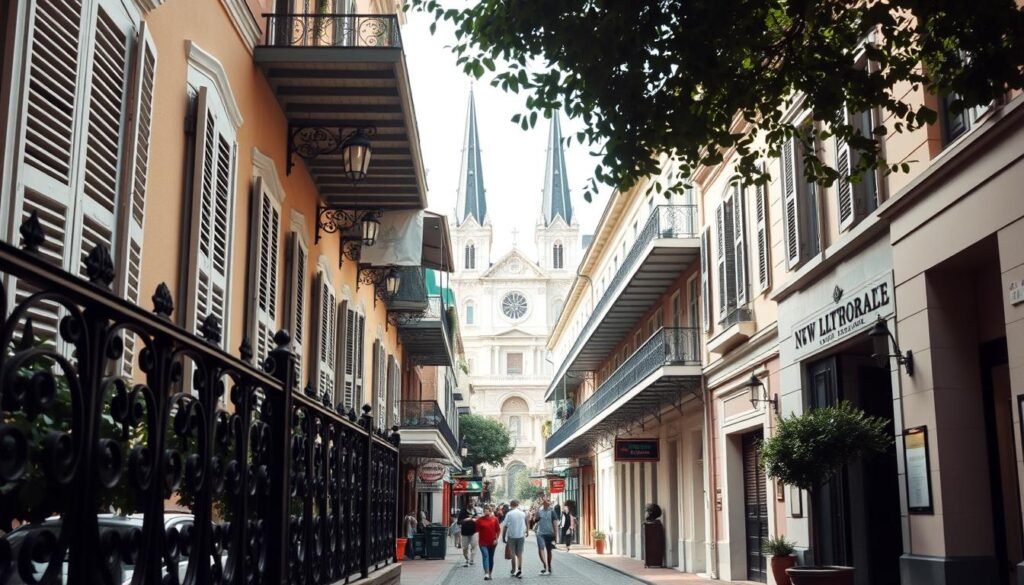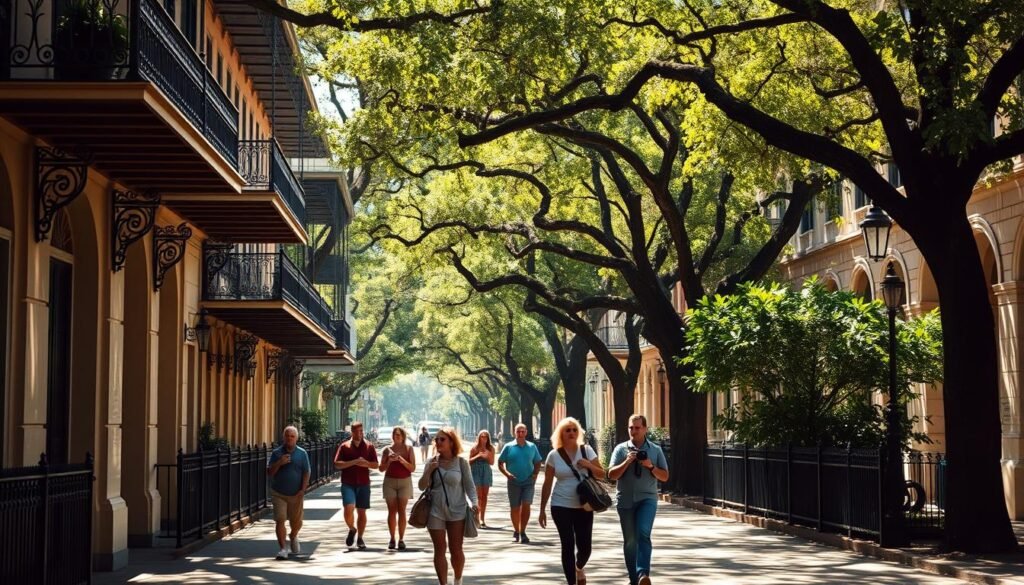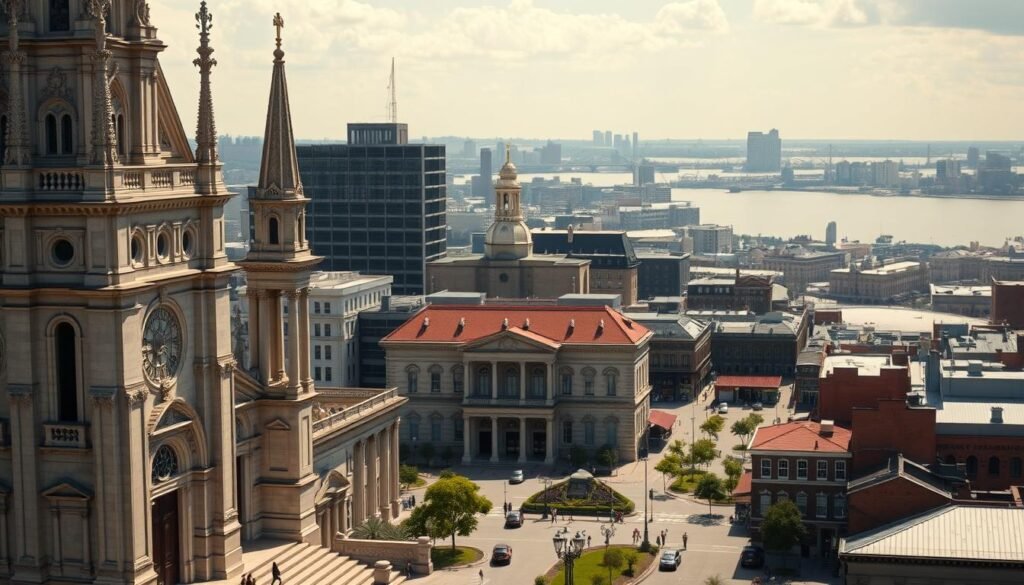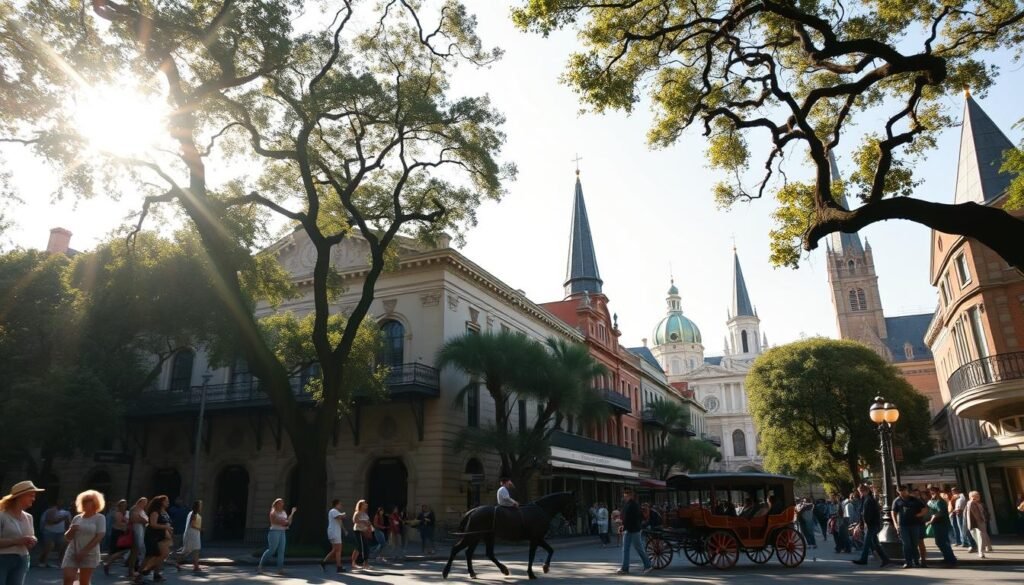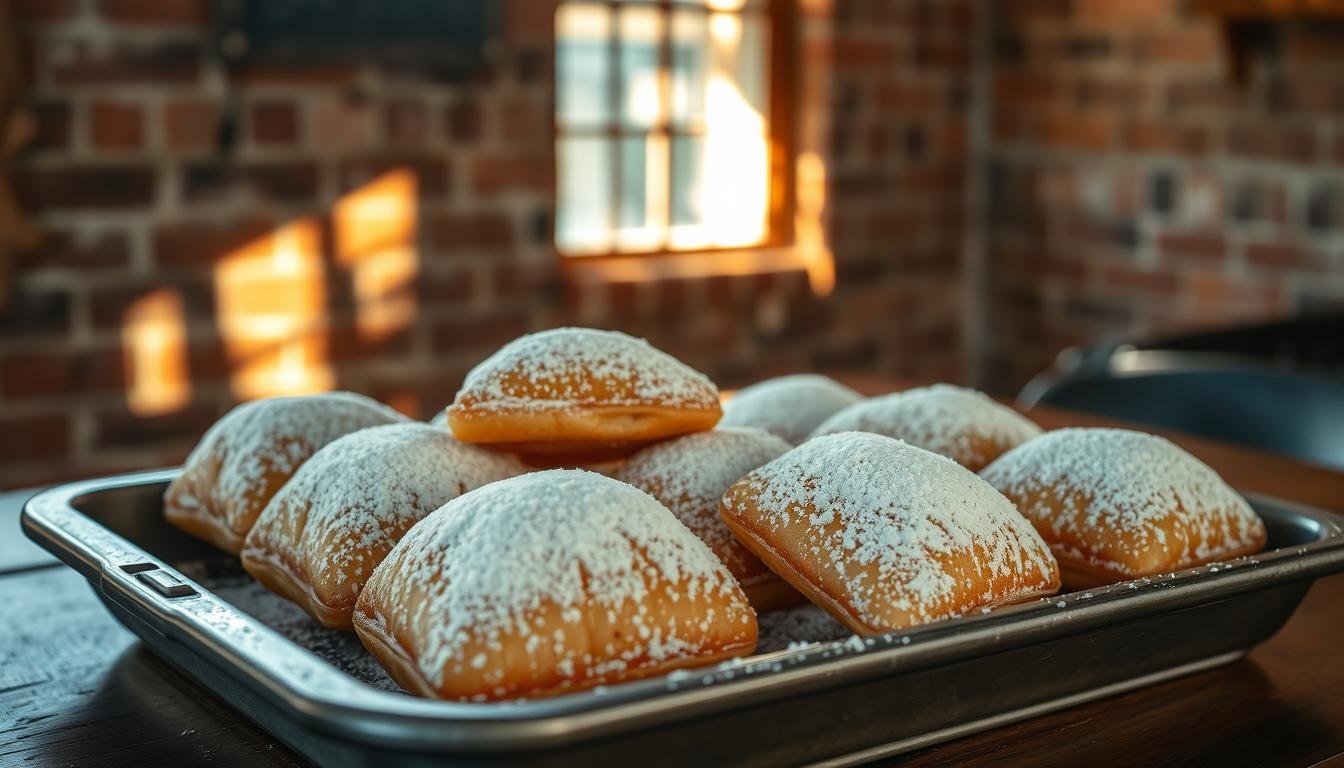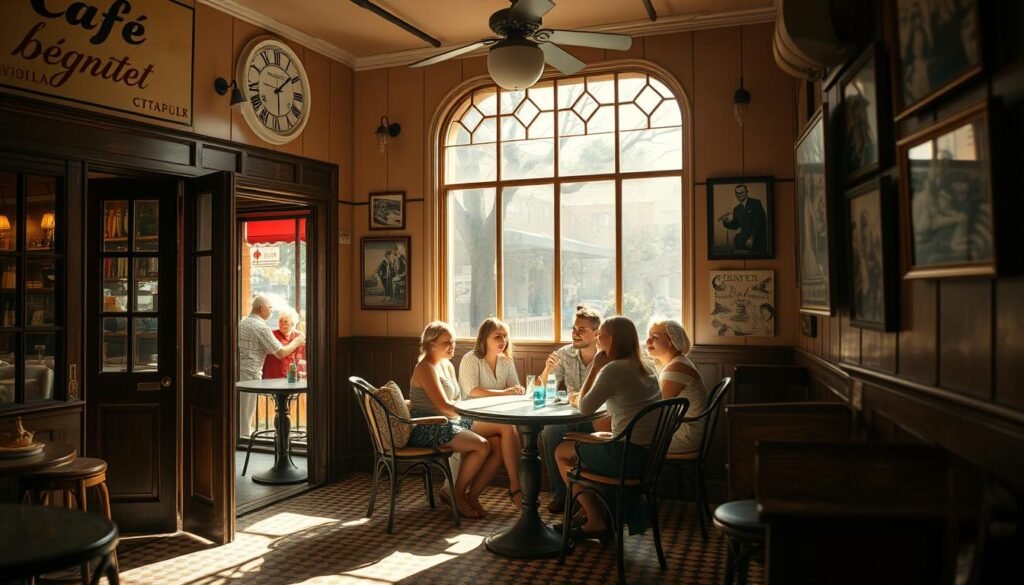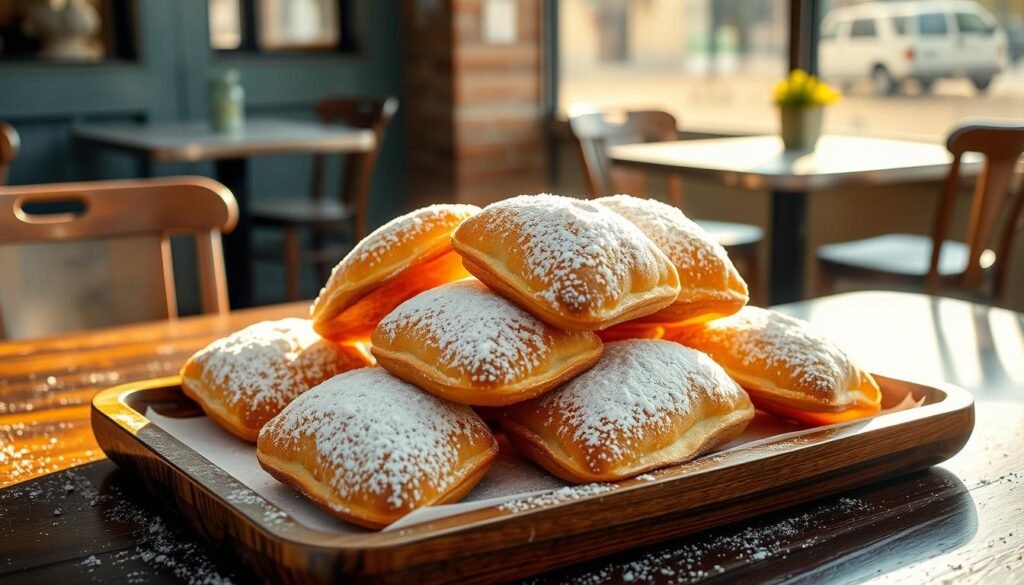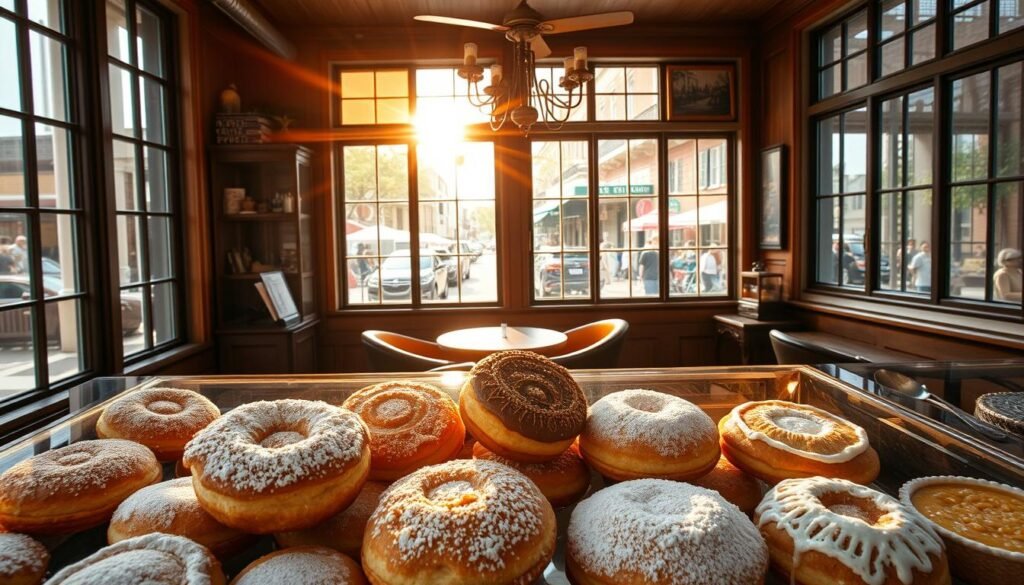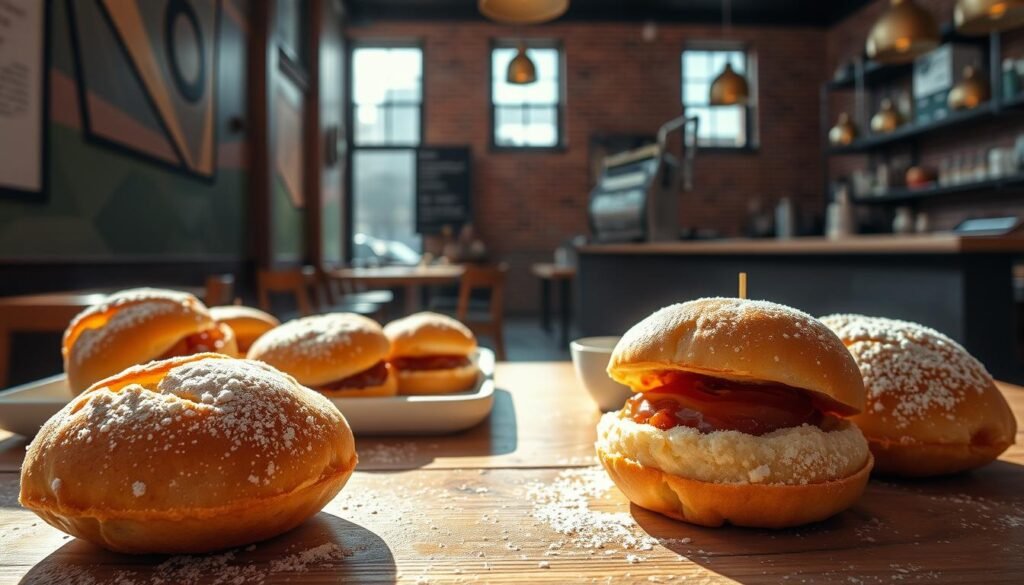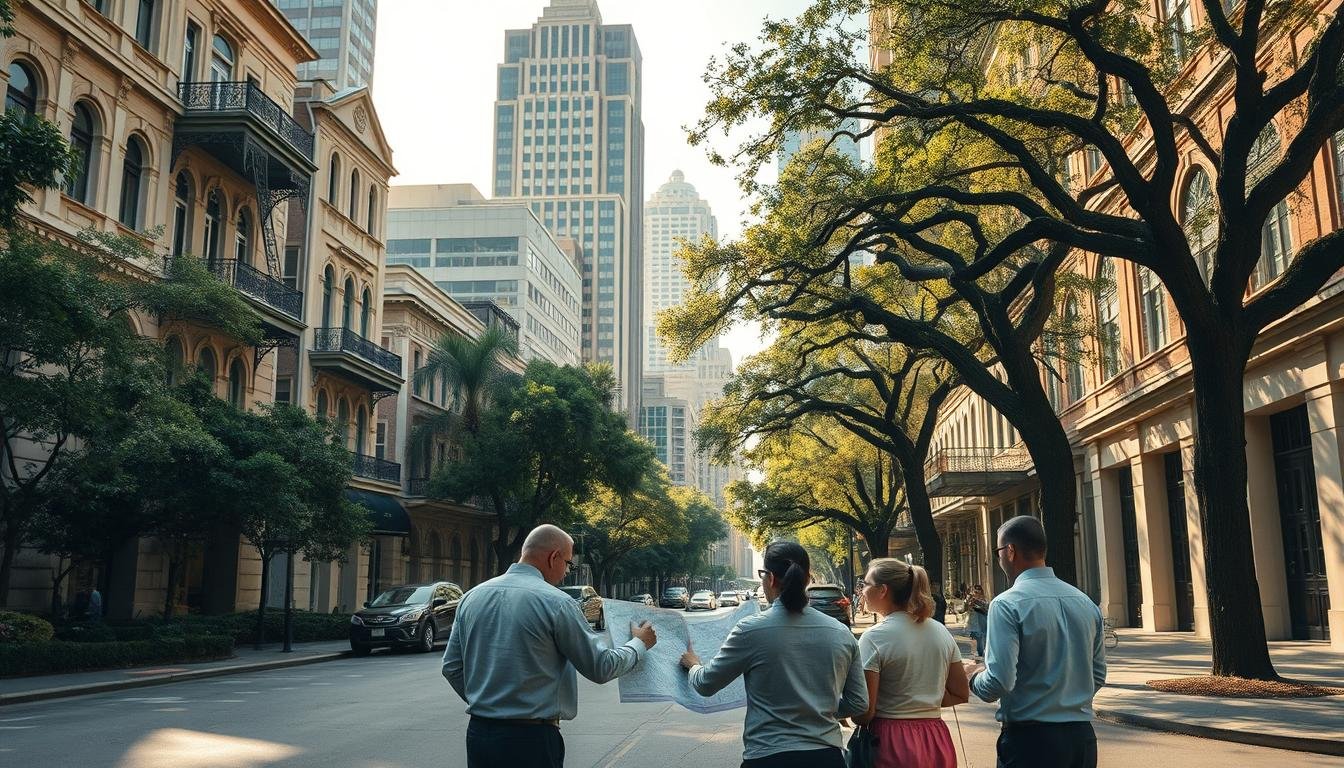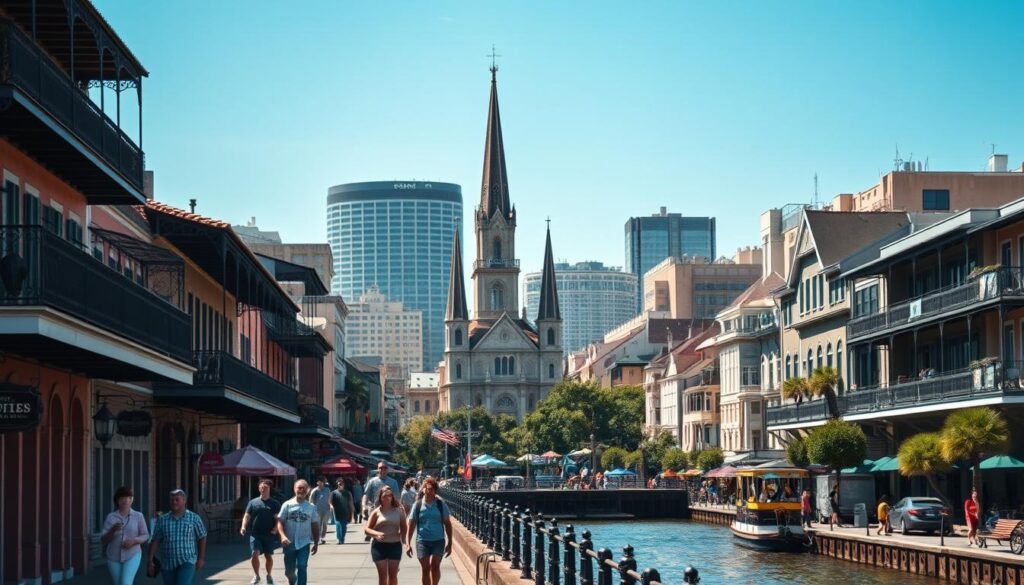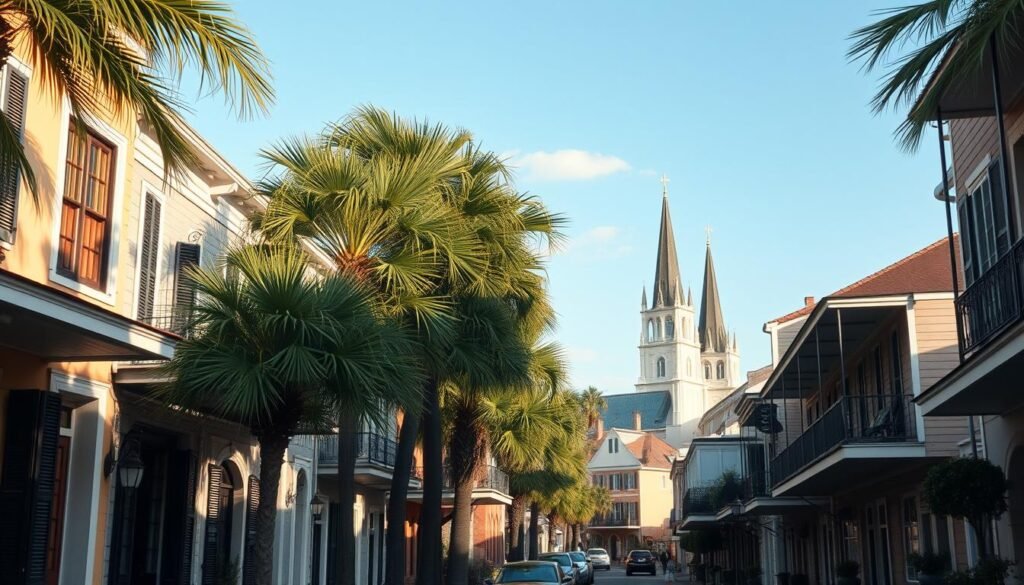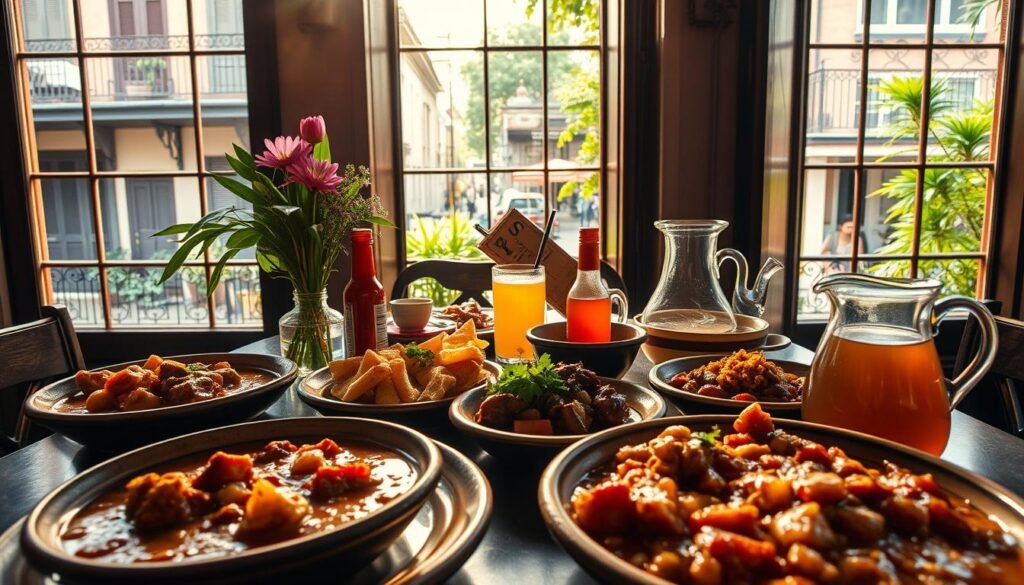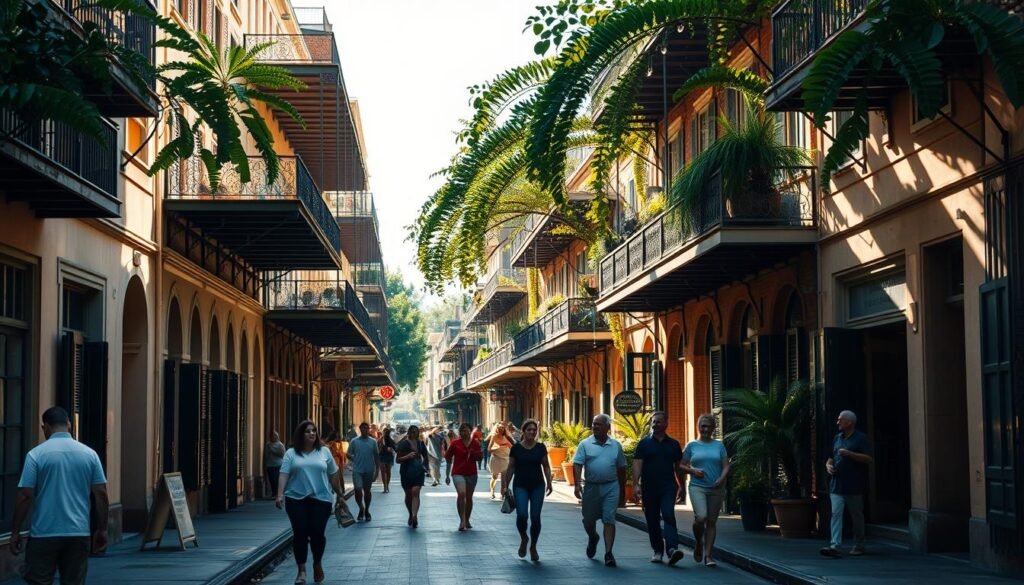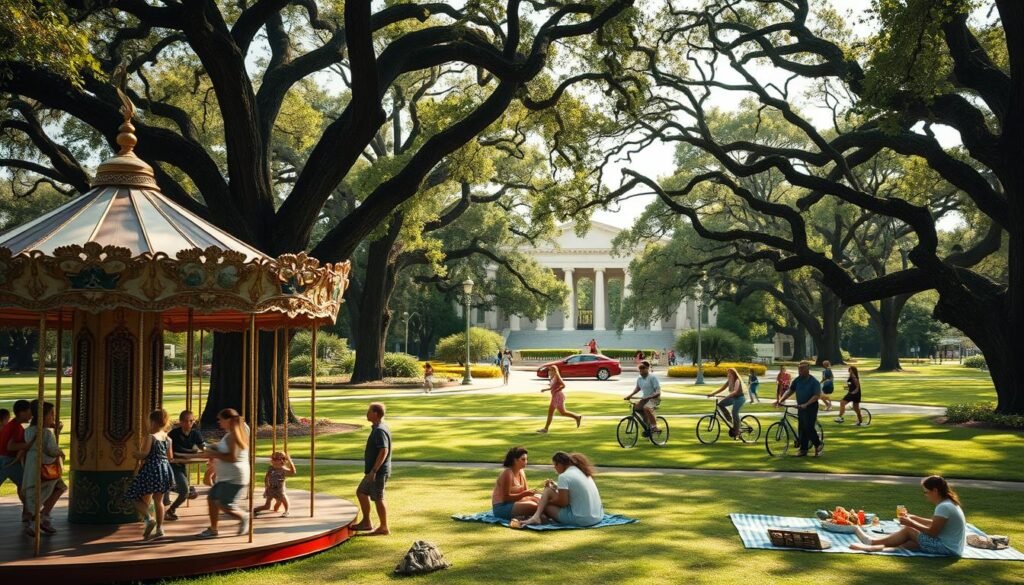As a local, I’m excited to share with you the essence of the city’s vibrant music culture – a melting pot of genres that have shaped the city’s identity. From soulful jazz to energetic street performances, the Big Easy is alive with the sound of music.
Growing up in this city, I’ve seen firsthand how music brings people together. It’s not just a form of entertainment; it’s a way of life. The city’s rich cultural heritage is reflected in its music, and I’m eager to take you on a journey through the heart of this iconic scene.
Key Takeaways
- Discover the history behind New Orleans’ unique music culture
- Explore the city’s most iconic music venues
- Meet the artists who keep the city’s music scene alive
- Learn about the cultural influences that shape the city’s music
- Find out why New Orleans is the perfect destination for music lovers
The Heartbeat of New Orleans: A Musical Legacy
New Orleans is the birthplace of jazz, and its musical legacy continues to pulse through the city’s veins. The city’s unique cultural melting pot has given rise to a diverse range of musical genres, from jazz and blues to zydeco.
The rich musical heritage of New Orleans is a testament to its history and the creativity of its people. As we explore the city’s musical identity, we’ll delve into the origins of jazz, highlight famous jazz legends, and examine the birth of other influential genres.
The Origins of Jazz in New Orleans
Jazz originated in the late 19th and early 20th centuries in the African-American communities of New Orleans. The genre is a blend of African and European music traditions, characterized by its improvisational nature and syncopated rhythms.
The French Quarter, with its vibrant jazz clubs, played a significant role in the development of the genre. Legendary jazz musicians like Louis Armstrong and Jelly Roll Morton got their start in these iconic clubs, which continue to thrive today.
Famous Jazz Legends from the City
New Orleans has been home to many famous jazz legends, including Louis Armstrong, Jelly Roll Morton, and Sidney Bechet. These musicians helped shape the sound of jazz and paved the way for future generations.
| Jazz Legend | Contribution |
|---|---|
| Louis Armstrong | Revolutionized jazz with his trumpet playing and vocals |
| Jelly Roll Morton | One of the first great jazz composers and pianists |
| Sidney Bechet | Sophisticated soprano saxophone playing and compositions |
Birth of Other Genres: Blues and Zydeco
In addition to jazz, New Orleans is also known for its blues and zydeco music scenes. The city’s blues music scene has been influenced by its African-American heritage, with musicians like Professor Longhair and Dr. John making significant contributions.
Zydeco, a genre that originated in Louisiana’s Creole communities, is characterized by its fast-paced accordion-driven rhythms. The genre has become an integral part of the city’s musical identity, with many zydeco bands performing in the French Quarter and beyond.
Iconic Venues That Define the Scene
From intimate jazz clubs to sprawling outdoor festivals, New Orleans’ iconic venues are the heartbeat of its music scene. These legendary spots not only showcase the city’s rich musical heritage but also provide unforgettable experiences for both locals and visitors.
The Preservation Hall Experience
Preservation Hall is a must-visit destination for anyone looking to immerse themselves in the traditional sounds of New Orleans jazz. This intimate venue is dedicated to preserving the legacy of jazz through performances by some of the city’s most revered musicians.
The hall’s reverence for tradition is palpable, with an atmosphere that feels like stepping back in time. The music is raw, emotional, and utterly captivating, making for an experience that’s both hauntingly beautiful and deeply moving.
The Local Vibe at Tipitina’s
For a taste of the local music scene, Tipitina’s is the place to be. This iconic club has been a staple of New Orleans music for decades, hosting acts that range from local legends to emerging artists.
The energy at Tipitina’s is electric, with a crowd that’s always ready to dance. Whether you’re there to see a big-name act or discover new talent, the vibe is always lively and infectious.
House of Blues: A Cultural Hotspot
House of Blues is another iconic venue that brings the best of New Orleans music to the stage. With its eclectic mix of acts and vibrant atmosphere, it’s a cultural hotspot that’s not to be missed.
From blues and jazz to rock and beyond, House of Blues hosts a diverse range of performances that cater to all musical tastes. The venue’s commitment to showcasing local talent alongside national acts makes it a unique and exciting destination.
The Joy of Open-Air Festivities
New Orleans is perhaps best known for its outdoor festivals, where music fills the air and the community comes together to celebrate. These events are a joyous expression of the city’s spirit, with multiple stages featuring a wide range of acts.
From the French Quarter Festival to Jazz Fest, these open-air festivities are a highlight of the city’s cultural calendar. They offer a unique opportunity to experience the diversity and richness of New Orleans music in a lively, communal setting.
| Venue | Music Style | Atmosphere |
|---|---|---|
| Preservation Hall | Traditional Jazz | Intimate, Historic |
| Tipitina’s | Local Music, Rock | Energetic, Lively |
| House of Blues | Diverse (Blues, Jazz, Rock) | Vibrant, Eclectic |
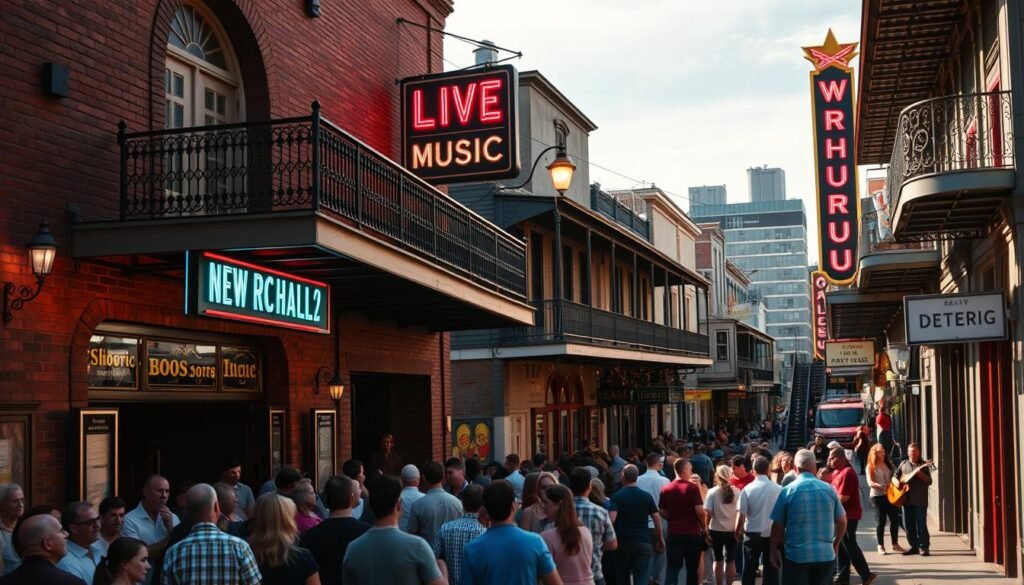
Celebrating Festivals: Music in the Air
New Orleans comes alive with music during its festivals, showcasing the city’s vibrant cultural heritage. The city’s festivals are a celebration of its rich musical diversity, drawing visitors from around the world to experience the unique sounds and energy of New Orleans.
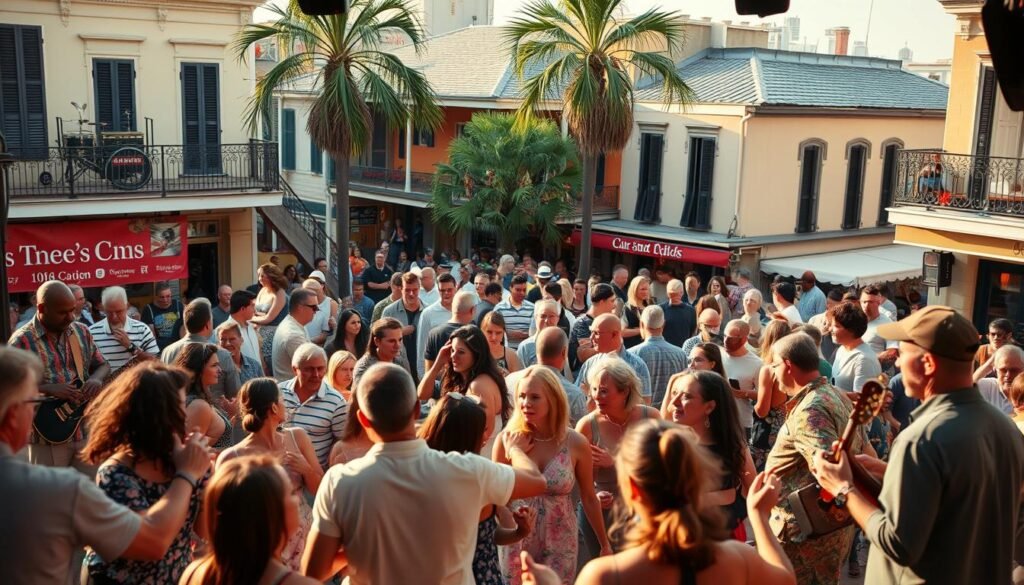
The Vibrancy of Jazz Fest
Jazz Fest is one of the crown jewels of New Orleans’ festival calendar, celebrating the city’s jazz heritage in a grand manner. The event features a diverse lineup of local and international artists, showcasing a wide range of jazz styles, from traditional to contemporary. It’s not just about the music; Jazz Fest is also a culinary and cultural experience, with local cuisine, crafts, and cultural exhibitions adding to the festival’s vibrancy.
The festival’s atmosphere is electric, with multiple stages hosting performances simultaneously, creating a dynamic where you can easily move from one great act to another. Whether you’re a jazz aficionado or just a lover of live music, Jazz Fest offers an unforgettable experience.
Unique Sounds of the French Quarter Festival
The French Quarter Festival is another highlight of New Orleans’ musical calendar, celebrating the city’s music, food, and culture in the historic French Quarter. This free event features numerous stages with a variety of local musicians, from jazz and blues to zydeco and gospel, creating a lively atmosphere that permeates the historic streets.
One of the unique aspects of the French Quarter Festival is its intimate setting, allowing for a close and personal experience with the musicians. The festival also highlights the culinary delights of the city, with numerous food vendors offering Creole cuisine and other local specialties.
Mardi Gras and Its Musical Significance
Mardi Gras is perhaps the most iconic of New Orleans’ festivals, known worldwide for its parades, costumes, and, of course, music. The event is a significant part of the city’s musical culture, with numerous parades and parties featuring live music. From brass bands to jazz ensembles, the music is an integral part of the Mardi Gras experience, adding to the festive atmosphere.
The musical significance of Mardi Gras lies in its ability to bring together different communities and cultures through music. It’s a time when the city’s rich musical heritage is on full display, with both traditional and contemporary sounds being celebrated.
Essential Local Acts to Discover
The essence of New Orleans music lies in its local acts – the ones who keep the traditions alive while pushing the boundaries of sound. As a local, I’ve had the privilege of witnessing the city’s music scene evolve, and I’m excited to share with you the talented artists and innovative collaborations that are making waves right now.
Trending Artists Making Waves
Artists like Rebirth Brass Band and Treme Funktet are not just names; they’re the heartbeat of the city’s streets, bringing energy to every performance. Their music is a testament to the enduring spirit of New Orleans, blending traditional jazz with modern funk and brass band rhythms.
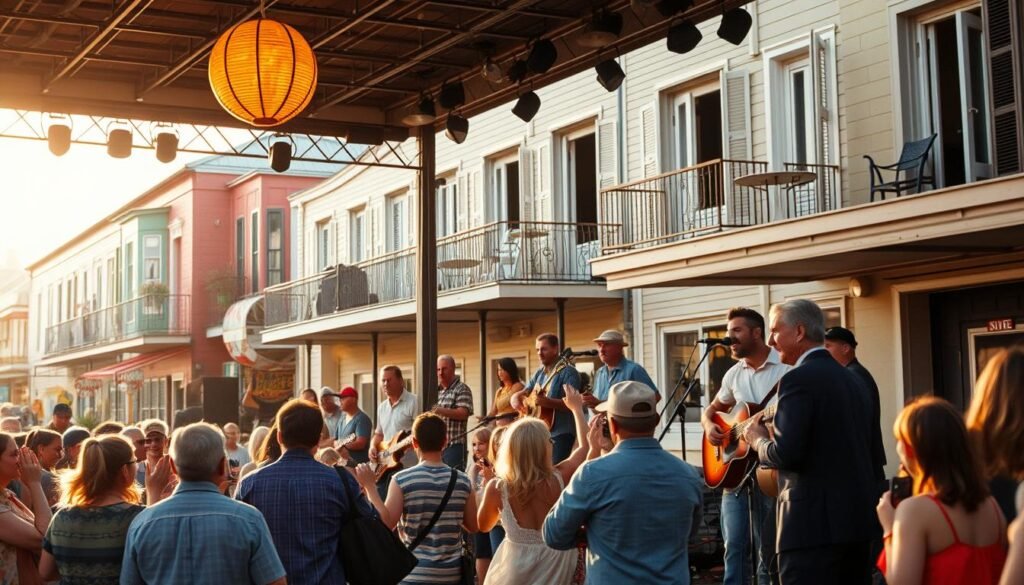
Groundbreaking Collaborations
One of the most exciting aspects of the New Orleans music scene is the spirit of collaboration. When artists from different genres come together, the result is often something entirely new and innovative. For instance, the collaboration between Jon Cleary and the Absolute Monster Gentlemen has produced some truly groundbreaking music, merging blues, rock, and soul in a way that’s uniquely New Orleans.
Rising Stars in the Music Scene
Keeping an ear to the ground, you can hear the rising stars of the New Orleans music scene. Artists like Morgan Pryor are making names for themselves with soulful voices and genre-bending styles. These emerging talents are not only keeping the music scene vibrant but are also ensuring its future.
As you explore the New Orleans music scene, keep an eye and ear out for these local acts. They’re the ones who make the scene so rich and diverse, offering something for every musical taste. Whether you’re a long-time fan of the city’s music or just discovering it, there’s always something new to enjoy.
The Role of Street Performers
The streets of New Orleans pulsate with the sounds of talented performers who make the city a living, breathing stage. Street performers are an integral part of the city’s music scene, adding a layer of spontaneity and energy that can’t be replicated in traditional venues.
Exploring the Frenchmen Street Vibe
Frenchmen Street is the epicenter of New Orleans’ live music scene, with venues like the Spotted Cat Music Club and Blue Nile showcasing local talent. But it’s not just the venues that make Frenchmen Street special – it’s the street itself, where you can often find impromptu performances that spill out onto the sidewalk.
Spotlight on Busking Culture
Busking is a time-honored tradition in New Orleans, with performers drawing crowds and collecting tips in popular spots like Jackson Square and along the Mississippi River. The city’s busking culture is a melting pot of styles, from jazz and blues to rock and pop.
- Musicians, jugglers, and other performers compete for attention and tips.
- The city’s relaxed attitude towards busking creates a welcoming environment for performers.
- Busking is a vital part of the city’s music ecosystem, providing a platform for new talent to emerge.
The Magic of Spontaneous Jams
One of the most magical aspects of New Orleans’ music scene is the spontaneous jam sessions that can erupt at any moment. Whether it’s a group of strangers coming together to play on the street or a impromptu performance in a club, these moments are pure New Orleans.
The magic happens when the music takes over, and the crowd becomes part of the performance.
The role of street performers in New Orleans is multifaceted – they entertain, they innovate, and they keep the city’s musical heritage alive. As you explore the city, be sure to stop and listen to the street performers, for they are the true embodiment of New Orleans’ spirit.
A Melting Pot of Musical Styles
New Orleans is renowned for its rich musical heritage, a true melting pot where diverse cultures blend seamlessly. The city’s unique position as a port city brought together people from various ethnic backgrounds, creating a fertile ground for musical innovation.
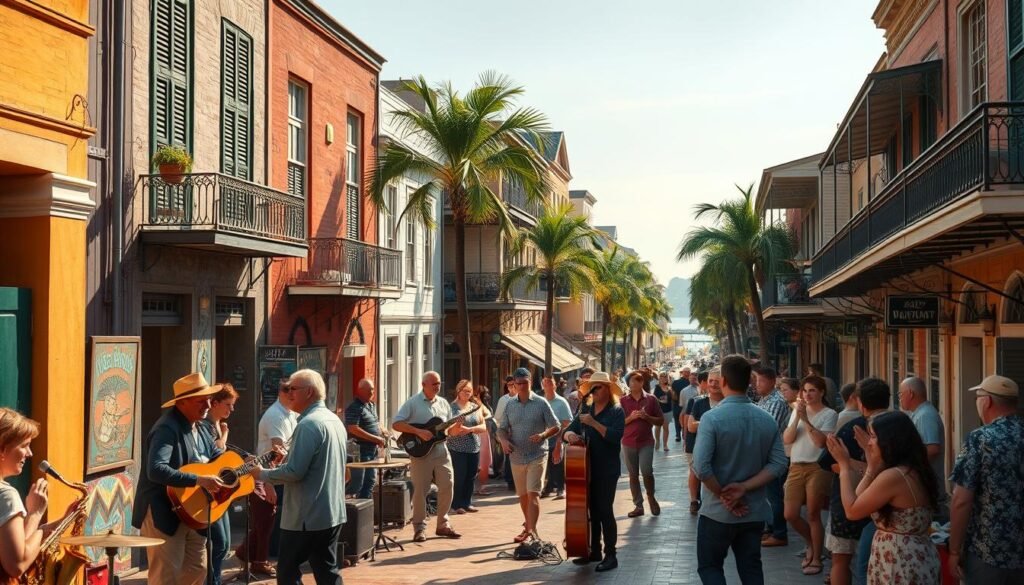
The Fusion of Cultures and Genres
The music scene in New Orleans is characterized by the fusion of different cultures and genres. African rhythms, European instrumentation, and Caribbean influences have blended together to create the distinctive sounds of jazz, blues, and zydeco.
- Jazz emerged as a unique blend of African American music traditions and European instrumentation.
- Blues music reflects the hardships and struggles of African American life, infused with soulful melodies.
- Zydeco, with its fast-paced accordion-driven rhythms, is a testament to the Creole culture’s vibrant heritage.
How Local Traditions Influence Music
Local traditions play a significant role in shaping the music of New Orleans. The city’s history, cultural practices, and community events all contribute to its musical identity.
Community and Cultural Events – Events like Mardi Gras and the French Quarter Festival are not just celebrations but also incubators for musical innovation. They provide a platform for local musicians to showcase their talents and for new traditions to emerge.
The Impact of Festivals on Modern Music
Festivals have a profound impact on the modern music scene in New Orleans. They not only celebrate the city’s musical heritage but also drive its evolution.
- Jazz Fest, one of the city’s most iconic festivals, brings together musicians from around the world, fostering collaboration and innovation.
- The French Quarter Festival celebrates the music of the French Quarter, highlighting the area’s unique cultural and musical heritage.
In conclusion, the melting pot of musical styles in New Orleans is a reflection of the city’s diverse cultural landscape. The fusion of cultures and genres, influenced by local traditions and driven by festivals, continues to shape the city’s vibrant music scene.
The Influence of Music on New Orleans Culture
In New Orleans, music isn’t just entertainment – it’s a way of life. The city’s vibrant New Orleans music scene is a reflection of its rich cultural heritage, where every note tells a story and every rhythm stirs the soul.
Music as a Means of Expression
For the people of New Orleans, music is a powerful means of expression. It’s a way to convey emotions, tell stories, and share experiences. As the great jazz musician Louis Armstrong once said,
“Music is life itself.”
This quote encapsulates the significance of music in New Orleans, where it serves as a universal language that bridges cultural divides.
Local musicians often use their music to express their personal experiences and the history of the city. For instance, the struggles and triumphs of the community are frequently reflected in the lyrics and melodies of local bands in New Orleans. This expression through music not only preserves the city’s history but also gives voice to its people.
Community and Connection Through Music
Music in New Orleans is also a communal activity that brings people together. Whether it’s a jazz jam session in the French Quarter or a zydeco dance party in the countryside, music has the power to unite people across different backgrounds. As the city’s residents often say,
“Music is the glue that holds our community together.”
The sense of community fostered through music is palpable during the city’s numerous festivals and events. For example, the New Orleans Jazz & Heritage Festival is not just a celebration of music; it’s a gathering of people who share a love for the city’s culture. This communal aspect of music is a defining feature of the New Orleans music scene.
Teaching the Next Generation
Preserving the musical heritage of New Orleans is crucial, and teaching the next generation is a key part of this process. Various programs and institutions in the city are dedicated to educating young musicians about the history and traditions of New Orleans music.
For instance, schools and music academies offer classes in jazz, blues, and other genres that are native to the city. By learning from experienced musicians, the next generation is able to carry forward the legacy of New Orleans music. As a local musician noted,
“Passing on our musical traditions is like passing on a part of ourselves.”
Through these efforts, the city ensures that its musical heritage continues to thrive, influencing not just the local culture but also the global music scene.
A Visitor’s Guide to Enjoying the Scene
As a local, I’m excited to share with you the ultimate guide to experiencing the vibrant New Orleans music scene. Whether you’re a seasoned music lover or just looking for a unique experience, the city has something for everyone.
Don’t Miss These Must-See Shows
New Orleans is home to some of the most iconic music venues in the country. You can’t miss the legendary Preservation Hall, where you can experience the raw energy of traditional New Orleans jazz in an intimate setting. Another must-see is the Spotted Cat Music Club, a cozy spot that’s perfect for discovering new talent.
“New Orleans is the birthplace of jazz, and it’s still the best place to experience it live.” –
Tips for Navigating the Music Hotspots
Navigating the New Orleans music scene can be a breeze if you know where to go. Start by exploring the French Quarter, where you’ll find some of the city’s most famous jazz clubs, like Snug Harbor and Irish Channel St. Patrick’s Day Parade isn’t the only thing that happens on the Irish Channel – there’s live music too!
For a more laid-back vibe, head to Frenchmen Street, where you’ll find a string of music venues and bars that are perfect for a night out. And don’t forget to check out the French Quarter Festival, which takes place every year and features some of the city’s best musicians.
Finding Authentic Experiences
One of the best things about New Orleans is its ability to blend traditional and modern music styles. To experience the authentic sounds of the city, be sure to check out some of the local street performers. You can find them on Jackson Square or on Bourbon Street, where they’ll be playing everything from jazz to rock to zydeco.
| Venue | Location | Music Style |
|---|---|---|
| Preservation Hall | 726 St. Peter St. | Traditional Jazz |
| Spotted Cat Music Club | 623 Frenchmen St. | Jazz, Blues |
| Snug Harbor | 626 Frenchmen St. | Jazz |
By following these tips, you’ll be well on your way to experiencing the best of the New Orleans music scene. Whether you’re looking for jazz, blues, or something else, the city has something for everyone.
The Future of the New Orleans Music Scene
The New Orleans music scene is at a crossroads – it’s a vibrant, thriving entity, yet it’s facing significant challenges. As we look to the future, it’s clear that the city’s ability to adapt while keeping its traditions alive is what will keep the music culture big easy thriving for generations to come.
Challenges and Opportunities
The COVID-19 pandemic has had a lasting impact on the New Orleans music scene, with many musicians struggling to make a living wage. As reported by Offbeat, multiple music venues are closing temporarily or permanently due to high operational costs and decreased audience numbers. However, this crisis also presents an opportunity for innovation and growth.
Preserving Heritage
Preserving the musical heritage of New Orleans is crucial to its future. The city’s unique blend of cultures and genres is what sets it apart, and it’s essential that this heritage is protected and passed on to future generations. Local musicians and music organizations are working tirelessly to ensure the New Orleans music scene remains vibrant.
What’s Next
So, what’s next for the New Orleans music scene? Emerging trends and innovations will likely play a significant role in shaping its future. As the city continues to evolve, it’s likely that new sounds and styles will emerge, blending traditional New Orleans music with modern influences. The future of the New Orleans music scene is bright, and it will be exciting to see how it continues to thrive.
FAQ
What’s the best way to experience the New Orleans music scene?
To truly experience the New Orleans music scene, immerse yourself in the city’s vibrant culture by visiting iconic venues like Preservation Hall and Tipitina’s, and exploring the lively street performances on Frenchmen Street.
What are some must-see music festivals in New Orleans?
New Orleans hosts several world-renowned music festivals, including Jazz Fest, French Quarter Festival, and Voodoo Music Experience, each showcasing the city’s rich musical diversity.
Can I find live music in the French Quarter?
Yes, the French Quarter is home to numerous jazz clubs, bars, and venues featuring live music, including the famous Bourbon Street and Frenchmen Street.
What role do street performers play in the New Orleans music scene?
Street performers are an integral part of the city’s music culture, adding a layer of spontaneity and energy to the streets, particularly on Frenchmen Street and in Jackson Square.
How has the New Orleans music scene influenced other genres?
The city’s unique blend of cultures and musical styles has significantly influenced the development of jazz, blues, and zydeco, shaping the course of American music.
Are there opportunities to discover new and emerging artists in New Orleans?
Absolutely, the New Orleans music scene is always evolving, with numerous venues and festivals showcasing emerging artists and local talent.
How can I support local musicians in New Orleans?
You can support local musicians by attending their performances, buying their music, and sharing their work with others, helping to keep the vibrant music scene thriving.
What’s the significance of Mardi Gras in the New Orleans music scene?
Mardi Gras is a significant event in the New Orleans music calendar, with parades, parties, and performances that showcase the city’s rich musical heritage and cultural traditions.
Can I take music lessons or classes in New Orleans to learn about the local music culture?
Yes, there are various music schools, instructors, and workshops in New Orleans offering lessons in jazz, blues, and other local genres, providing a great way to immerse yourself in the city’s music culture.
